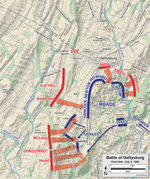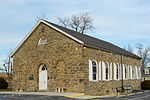Sachs Covered Bridge
1854 establishments in PennsylvaniaBridges completed in 1854Covered bridges in Adams County, PennsylvaniaCovered bridges on the National Register of Historic Places in PennsylvaniaLattice truss bridges in the United States ... and 3 more
National Register of Historic Places in Adams County, PennsylvaniaRoad bridges on the National Register of Historic Places in PennsylvaniaWooden bridges in Pennsylvania

The Sachs Covered Bridge , also known as Sauck's Covered Bridge and Waterworks Covered Bridge, is a 100-foot (30 m), Town truss covered bridge over Marsh Creek between Cumberland and Freedom Townships, Adams County in the U.S. state of Pennsylvania. The bridge was also known as the Sauches Covered Bridge at the time of the Battle of Gettysburg. It was listed on the National Register of Historic Places in 1980. During the American Civil War, both the Union and Confederate Armies used the bridge in the Battle of Gettysburg and its aftermath. It is reportedly known to be severely haunted as a result.
Excerpt from the Wikipedia article Sachs Covered Bridge (License: CC BY-SA 3.0, Authors, Images).Sachs Covered Bridge
Waterworks Road,
Geographical coordinates (GPS) Address Nearby Places Show on map
Geographical coordinates (GPS)
| Latitude | Longitude |
|---|---|
| N 39.797361111111 ° | E -77.276111111111 ° |
Address
Sachs Covered Bridge
Waterworks Road
17325
Pennsylvania, United States
Open on Google Maps








